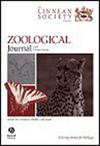A scientist’s guide to Solifugae: how solifuges could advance research in ecology, evolution, and behaviour
IF 3
2区 生物学
Q1 ZOOLOGY
引用次数: 0
Abstract
Despite having >1200 described species and despite their nearly worldwide distribution and prevalence in many xeric ecosystems, relative to many other arachnid groups, we know little about the natural history and behaviour of animals in the order Solifugae (camel spiders, sun spiders, sun scorpions, etc.). Here, we review the current solifuge literature through the lens of conceptual research areas in ecology, evolution, and behaviour and propose ways in which solifuges can contribute to research in specific subfields, as follows: (i) ecology: community and trophic dynamics; connecting food webs; habitat specialization; and biodiversity and conservation; (ii) evolution: speciation and diversification; activity cycles and associated traits; adaptations for speed; and living in extreme environments; and (iii) behaviour and sensory systems: sleep, quiescence, and diapause; sensory systems and sensory ecology; learning and cognition; and mating systems, sexual selection, and sexual conflict. This resource can provide a starting point for identifying research programmes that will simultaneously contribute basic natural history information about this under-studied group and provide a broader understanding of fundamental concepts and theories across the life sciences. We hope that scientists will take this review as a challenge to develop creative ways of leveraging the unique features of solifuges to advance scientific knowledge and understanding.科学家指南:溶虫如何推进生态学、进化论和行为学研究
尽管 Solifugae 目(骆驼蛛、太阳蛛、太阳蝎等)有 1200 个已描述的物种,尽管它们几乎遍布全球,而且在许多干旱生态系统中也很常见,但相对于许多其他蛛形纲动物,我们对它们的自然史和行为却知之甚少。在此,我们从生态学、进化论和行为学等概念性研究领域的角度,回顾了目前的溶岩蛛文献,并提出了溶岩蛛可以为特定子领域的研究做出贡献的方法,具体如下:(i) 生态学:群落和营养动态;连接食物网;栖息地特化;以及生物多样性和保护;(ii) 进化:物种分化和多样化;活动周期和相关特征;对速度的适应;以及在极端环境中生活;以及 (iii) 行为和感觉系统:睡眠、静止和休眠;感觉系统和感觉生态学;学习和认知;以及交配系统、性选择和性冲突。本资料可为确定研究计划提供一个起点,这些研究计划将同时为这一研究不足的类群提供基本的自然史信息,并为整个生命科学的基本概念和理论提供更广泛的理解。我们希望科学家们能将这篇综述作为一项挑战,开发出创造性的方法,利用溶菌群的独特特征来促进科学知识和理解。
本文章由计算机程序翻译,如有差异,请以英文原文为准。
求助全文
约1分钟内获得全文
求助全文
来源期刊
CiteScore
6.50
自引率
10.70%
发文量
116
审稿时长
6-12 weeks
期刊介绍:
The Zoological Journal of the Linnean Society publishes papers on systematic and evolutionary zoology and comparative, functional and other studies where relevant to these areas. Studies of extinct as well as living animals are included. Reviews are also published; these may be invited by the Editorial Board, but uninvited reviews may also be considered. The Zoological Journal also has a wide circulation amongst zoologists and although narrowly specialized papers are not excluded, potential authors should bear that readership in mind.

 求助内容:
求助内容: 应助结果提醒方式:
应助结果提醒方式:


